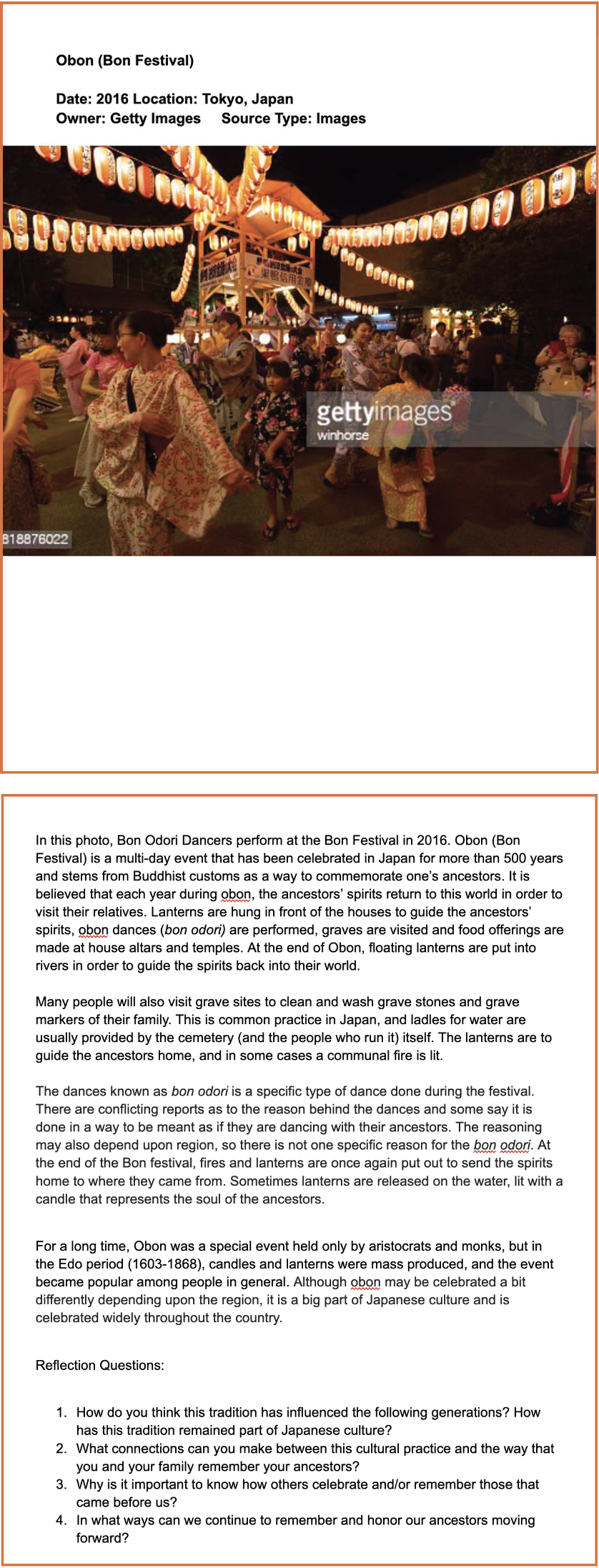Honoring the Memory of Ancestors
Themes: Cultural symbolism and meaning of monarch, ties to indigeneity, and remembering our ancestry.
Line

Activity 1: The Way We Remember (Our Ancestors)
Among some of the forest communities of central Mexico, monarchs are believed to be the souls of their ancestors. For others, monarchs carry the soul of a relative or friend who, for one night, returns to the world of the living. The “visit” is to celebrate Día de Muertos or Day of the Dead in the first days of November. During this time, people eat traditional foods, set-up an ofrenda (offering or altar) to their ancestors and celebrate in public spaces such as churchyards and plazas.
The Purépecha, indigenous peoples centered in the northwestern region of Michoacán, have tracked the monarch’s return to Mexico for centuries. The arrival of the butterfly, known as la parakata in Purépecha, meant that it was time for the corn harvest.
“The parakatas were also believed to be the souls of the dead visiting for the night of Día de Muertos (Monarch Joint Venture, 2020). The swaths of captivating monarchs flying overhead have continued to be an important connection between the living and the dead.”
Many cultures have their own ways to remember and celebrate the memory of their ancestors incorporating the natural world in their commemoration.
In this activity, participants will engage with cultural practices and historical images that highlight how other cultures honor previous generations (those that came before us). In pairs or small groups, invite students to take 10 minutes to discuss one image, read the image description, and critically reflect on the questions provided.
activity 1

Activity Note
Other than the questions attached to each photograph, students can also be prompted with the following questions: (1) What are some similarities and differences between the various practices depicted? (2) Why do you think these elements are included in their ways of honoring their ancestors? (3) Do you recognize some of the practices depicted? What connections can you make to some of these practices? (4) What are other ways you can honor an ancestor?
Educator’s Note
This activity encourages students to share their interpretations and individual cultural perspectives on how they remember their ancestors and reflect on their ancestry. Remembering our ancestors can be a sensitive topic for students, therefore, be sure to validate the diversity of your students’ memories, experiences, and their practices. The monarch butterfly can serve as an introduction to highlight the ancestral knowledge of indigenous communities and practices, elicit empathy of the past and other cultures, and acknowledge indigenous influence and personal ties.
Line

Activity 2: Dear Ancestor - Letter to a Monarch Butterfly in Your Life
The monarch butterfly has been given meaning via the Día de Muertos holiday as the butterflies have been said to represent carriers of souls to their final resting place. The monarch butterfly has also been used as a symbol for transformation and rebirth. While the butterfly reminds us that life and death are cyclical, it has also been used as a symbol in other ways such as political campaigns to advocate for immigration reform.
Activity 2

Our families, and at times ourselves, have experienced some form of (im)migration whether
that is through crossing international borders, moving between states, or from neighborhood to neighborhood.
The goal of this activity is for students to choose a family member from the past or present who has made their own im(migration) journey and can “be” a monarch butterfly whose journey the student’s reflect on.
Write a “Thank You” letter (personal message) to an ancestor while addressing/reflecting on the following questions:
- Who in your family comes to mind when you think of the monarch butterfly and its
migration journey? - What would you like the “monarch butterfly” in your family to know and what would you like to thank them for?
- How will you honor the memory of your ancestor based on the life you plan to live?
Activity Note
As an option, students can cut out paper monarchs to decorate using various art materials and write their response on the back of the faux butterflies. After the students have written their letter, encourage them to share which ancestor they selected to be their “monarch butterfly” and how they will continue to honor their ancestor.
Educator’s Note
Reiterate to students that as we conjure the symbol of the monarch butterfly to write a letter to an ancestor, that it is important to be inclusive of the variety of movement and experiences that their ancestors/themselves may have (moved once from city to city, across national borders, neighborhoods, etc.). Encourage students to draw inspiration from the movement of the natural world. Again, acknowledge that not all people have had the same agency or freedom of choice in their movement and thus our personal, family, or community experiences may differ.